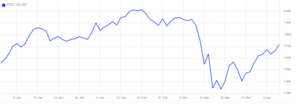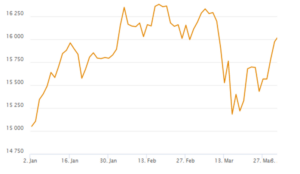After a 2022 weighed down with recession fears, the start of 2023 saw worries begin to recede, lifting hopes that this year would be brighter in terms of economic output. That said, the beginning of the year didn’t come without its dramas, with the closure of Silicon Valley Bank and near collapse of Credit Suisse causing shockwaves in the financial sector.
In the first three months of the year inflation in many parts of the world remained stubbornly high, something the Organisation for Economic Cooperation and Development (OECD) expressed concern about. As a result, it urged central banks to maintain high interest rates to help fight inflation.
That said, the OECD – which aims to stimulate economic progress and world trade – echoed the more optimistic mood when it predicted that most of the major EU economies would expand at a stronger pace than forecast last year.
Read on to discover more about the events of Q1 2023, and how they affected the markets.
UK
While the OECD was more upbeat about Europe’s economy, the media revealed that it still expected Russia and the UK’s to shrink. This was echoed by the Bank of England’s (BoE) quarterly forecasts, which in January said it still expected the UK to fall into a recession later in 2023.
There was some good news though, as the BoE said the recession would be less severe than previously thought. Despite this, the latest quarterly GDP figures from the Office for National Statistics (ONS) revealed that Britain’s economy had not contracted in Q4 2022.
In fact, it grew by 0.3% in January with the largest contributions coming from education, transport and storage, as well as entertainment and recreation activities. This means that the UK economy technically dodged a recession, as it avoided two consecutive quarters of decline after contracting in Q3 of 2022.
The BoE’s Monetary Policy Committee voted to increase the base interest rate to 4.25% in March, as inflation remained a key concern for the central bank. Despite early signs that inflation was finally beginning to subside, it unexpectedly rose to 10.4% in the year to February 2023.
March saw the chancellor, Jeremy Hunt, deliver his spring Budget, which he called “a plan for growth”. This included several key announcements including:
- An extension of the Energy Price Guarantee until the end of June 2023
- Removal of the pensions Lifetime Allowance (LTA)
- An increase to several pension allowances
- A year-long extension to the 5p cut to fuel duty on petrol and diesel, which was due to end in April 2023.
After hitting a new record high in February 2023, the FTSE 100 fell back in March. This was sparked by fears over the global banking sector, which resulted in the FTSE 100 closing around 3.8% lower on 15 March – making it the worst day of trading since the start of the Covid pandemic.
As you can see from the following illustration though, the index still finished higher than where it began Q1 of 2023.

Source: London Stock Exchange
Europe
The PMI for manufacturing in the eurozone reached 54.1 in March, which suggested that the OECD’s optimism for its economic future wasn’t misplaced. As the PMI measures activity in the manufacturing and services sector the reading is good news, as any figure above 50 signals expansion.
While the main rate of inflation in the Eurozone dropped to 6.9% in March, the European Central Bank raised its main interest rate to 3.5%.
Despite the volatility in the banking sector, European equities broadly provided strong gains in Q1 of 2023, largely led by the information technology and communication services sectors. Even with the Silicon Valley Bank and Credit Suisse crisis, the eurozone’s financial sector posted overall gains during Q1.
The following index shows the performance of the MSCI European Index during Q1 2023, which tracks a basket of companies from 15 EU nations. As you can see, while the index fell towards the end of the period, it still finished higher than where it started.

Source: MSCI Europe
US
The turbulence created by the collapse of Silicon Valley Bank in March turned out to be short-lived, and didn’t dampen the performance of US equities. Even with inflation remaining uncomfortably high, the S&P 500 ended the quarter around 7% up.
The tech-heavy Nasdaq soared nearly 17% in its best quarterly gain since Q4 of 2020, while the Dow Jones rose about 0.4%.
The Federal Reserve (Fed) raised interest rates twice during Q1, taking the upper limit of US interest rates to 5%, the highest level since 2007. The annual inflation rate in the US slowed to 6% in February of 2023, the lowest since September 2021.
The inflation rate, which was in line with market forecasts, was lower than January’s 6.4%. The US’s PMI was 49.2 in March 2023, which means it’s still in contraction territory as it’s below 50. That said, it’s higher than February’s figure of 47.3.
Asia
Asia (ex Japan) equities made strong gains thanks to a positive performance by stocks and shares in Taiwan, Singapore and South Korea. These offset weaker performances by Hong Kong, India and Malaysia.
Equities in China also enjoyed strong gains at the start of 2023 thanks to Beijing loosening its Covid restrictions, which had previously constrained economic growth in the country. This was further enhanced by China’s loosening of the regulatory crackdown on its technology companies.
Stocks and shares in Japan rose strongly in Q1, with the TOPIX up 7.2% in yen terms. This was despite mixed results being announced during the quarterly earnings results, which took place between late January and mid-February.
Get in touch
If you need advice on any aspect of our Q1 investment update, please get in touch. If you would like to discuss how investing might benefit your wealth, or discover how we might be able to help your finances, email admin@stonegatewealth.co.uk or call us on 01785 876222.
Please note
This blog is for general information only and does not constitute advice. The information is aimed at retail clients only.
The value of your investment can go down as well as up and you may not get back the full amount you invested. Past performance is not a reliable indicator of future performance.


 Production
Production
